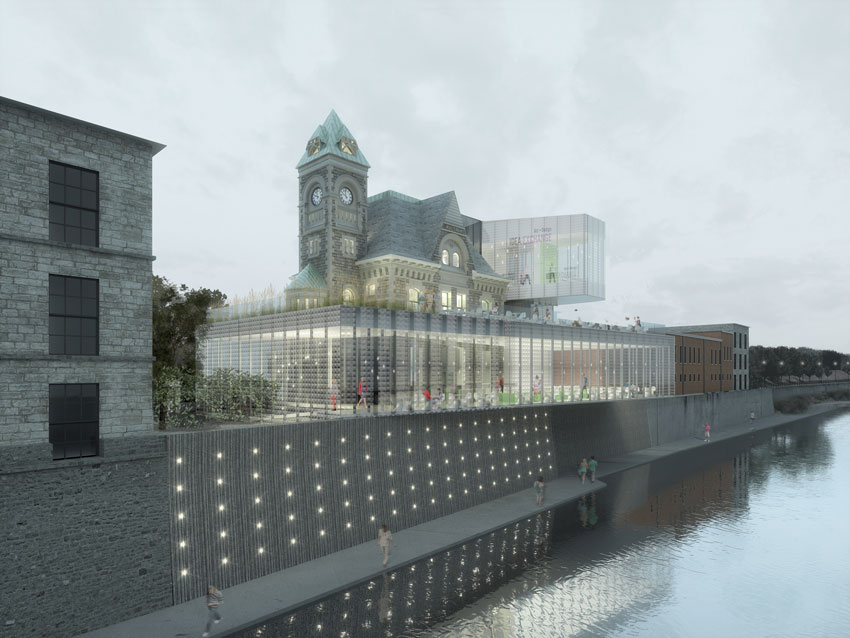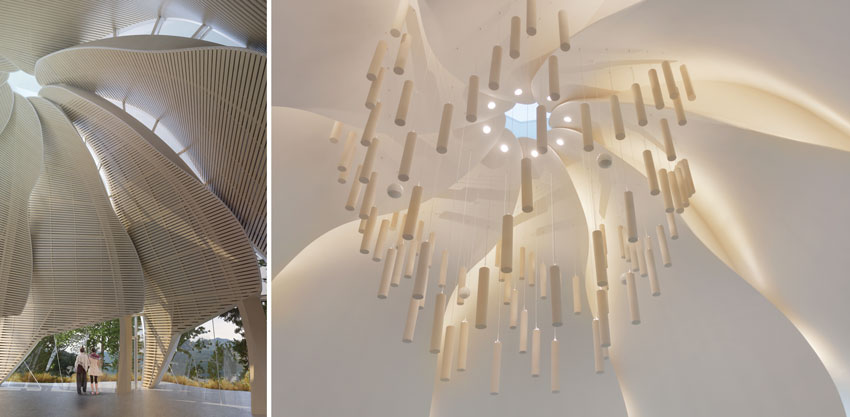Acoustics


IMAGES: COURTESY RDHA (TOP); © CASEY DUNN (BOTTOM)
BEYOND THE BOOK
RDHA’s Idea Exchange (top) in Cambridge, Ontario, and the Central Libarary (bottom) in Austin, Texas, by Lake|Flato and Shepley Bul-finch, represent a new generation of library, with spaces that can accommodate a wide range of programming.
Dubbed Canada’s first bookless library, the Galt Idea Exchange, scheduled to open in spring 2018, engages creative people of all ages. The project renovates a 9,000-square-foot heritage post office, adding a new transparent pavilion that doubles the post office’s floor area and cantilevers 20 feet over the Grand River. The lower level offers a black-box theater and multipurpose room, audiovisual recording suites, and studios for playing musical instruments on loan. An atrium connects to the main level, which includes a periodicals reading room, café, and restaurant. Upstairs, the Children’s Discovery Centre and the adult Creation Space offer opportunities ranging from robotics and 3-D printing to woodworking and sewing. Part of a municipal library system, the Idea Exchange complements an existing book-based library in the community.
Similarly, the Austin Central Library, a 200,000-square-foot facility that opened in October, celebrates books and reading. Jonathan Smith, an associate partner at Lake|Flato, calls it the best daylit library in America, due in large part to a six-story atrium that includes extensive skylights, clerestories optimized for their solar orientations, and a generous east-facing curtain wall. The facility also extends its capacity for community engagement with a 250-seat event space, meeting rooms, art gallery, café, screened porches for reading overlooking Lady Bird Lake, and a rooftop garden, as well as dedicated multiuse areas for children and teens.
“The goal for any community space is to provide a comfortable acoustic environment for multiple applications,” says Payam Ashtiani, a principal with Mississauga, Ontario–based Aercoustics Engineering, consultants to the Galt Idea Exchange. To achieve that goal, the acoustic design must address three primary factors: room acoustics (the behavior of sound in the space), sound isolation (the exclusion of noise from outside the space), and mechanical-noise control (the control of sound from building services). Ken Dickensheets, principal of Austin-based Dickensheets Design Associates, acousticians for the Austin Library, concurs. He adds that acoustic analysis early in the design process maximizes the opportunities for cost-effective solutions.
The distribution of program elements, for example, can simplify acoustics by locating zones that require quiet away from sources of noise, including mechanical equipment. The Austin Library’s event space is on the lower level for this reason, as are the Galt Idea Exchange’s performance and recording spaces.
Once the opportunities for passive solutions have been fully taken advantage of, floors and walls can be designed to further isolate spaces. An assembly’s Sound Transmission Class (STC) rating describes its ability to attenuate the trans¬mission of sound in the audible frequency range. In general, good acoustic separation between adjacent spaces can be provided with demising partitions that have an STC rating of 45 to 50.

PHOTOGRAPHY: © DANIEL SÉGUIN
RESTFUL RETREAT
The form of Patkau Architect’s Temple of Light, a sanctuary and meeting place for the Yasodhara Ashram, was inspired by the shape of a previous building destroyed by fire, and its spectacular setting in the mountains of southeastern British Columbia.
At the Idea Exchange, STC-50 is achieved for multipurpose-room walls with two layers of ⅝-inch gypsum board on either side of 3⅛-inch, fiberglass-insulation-filled steel studs. For the recording suite, which requires a higher STC rating, the insulated studs are doubled on either side of a 2-inch air gap. To prevent sound flanking (the transmission of sound around, over, or under the primary partition separating two spaces), the suite’s concrete floor slab is isolated from the structure with neoprene gaskets.
Within a room, reverberation time (RT) is defined as the interval in which sound decays by 60 decibels (dB). (Decibels are the logarithmic unit used to measure the intensity of sound.) To prevent collaborative spaces’ becoming too noisy, the target RT for the Idea Exchange’s Creation Space was less than one second, with a low of 0.6 seconds for the recording studios. For the atrium, an RT of 1.2 to 1.5 seconds maintains the feeling of a large, open space without allowing noise to build to a din.
The Idea Exchange primarily uses perforated acoustic drywall to achieve the desired Noise Reduction Coefficients (NRCs). The material meets a budget that Tyler Sharp, principal at RDHA, describes as difficult, given the ambitions of the project. But it also has desired aesthetic qualities, says Sharp. Its continuous, uniform dot pattern flows evenly across the atrium ceiling’s angular geometry, and the dots relate neatly to the pattern of the curtain wall’s ceramic frit.
To achieve the NRC required for its atrium, the Austin Library uses acoustical plaster on the ceiling and undersides of projecting floor slabs. A relatively expensive material that shows abuse, acoustical plaster suits these out-of-the-way applications. Two large, south-facing walls designed to reflect daylight into the library are clad with perforated metal panels backed with acoustical batts to prevent them from also reflecting sound. “The fact that this giant volume isn’t echoey makes the building feel more approachable,” says Smith. “It doesn’t show in the photos, but when you’re there, you have a great feeling in the space.”
If acoustic tranquility is welcome even in the new, more dynamic breed of library, it is a necessity in the Temple of Light, a sanctuary and meeting place for the Yasodhara Ashram, a yoga retreat and study center in the mountains of southeastern British Columbia. The new temple, designed by Vancouver-based Patkau Architects and completed this summer, replaces an earlier one destroyed by fire.
The temple responds to the collective memory of the original space (which comprised eight rotationally symmetric bays, like its replacement). But it also takes cues from the spectacular clifftop site, with its views of Kootenay Lake and the surrounding forest, and from the lotus flower, an important symbol in the yogic tradition, says Luke Stern, manager of design research at Patkau.
Constructed of prefabricated wood panels’ acting in concert with glulam arches and shear wall elements, creating an integral shell, the temple is the focal point of the spiritual life of the ashram. The form of the primary volume, pinwheel in plan, is made up of eight interlocking petals, curvilinear yet built of straight members, and radiating from a central oculus.

IMAGES: COURTESY PATKAU ARCHITECTS
FLOWER POWER
An early scheme for the Temple of Light included wood slats with acoustic backing (left) on the underside of its petals. These interior surfaces were ultimately constructed of painted drywall with compound curves, to help mitigate sound-focusing problems. A chandelier of melamine-foam baffles (right) absorbs excess acoustical energy.
Because of the project’s modest budget of $2.75 million, the design team could afford only a simplified approach to acoustic modeling. The acoustic consultants, Vancouver-based RWDI, offered advice based on the sound quality of a simple dome, without the compound curves of the eight petals, in which the RT would reach 3.5 seconds or longer. (An echoey gymnasium has an RT of about 2 seconds.) The architects knew that the design’s curves would mitigate the long RT but considered additional measures to be in order.
The temple’s unusual geometry was designed in part to mitigate the focusing issues that afflict simple domes. There are no parallel surfaces that would cause significant harmonic resonances or flutters, says Stern, and where concave surfaces occur, they are not centrally focusing, so that acoustic hot spots from each of the eight petals don’t overlap. Moreover, those hot spots mainly occur above head height.
At the base of the petals, which are finished in white-painted gypsum board, glazing provides views of the temple’s lakeside setting. To prevent sound’s ricocheting off the hard surface of the glass and back to the building’s occupants, the architects segmented and angled the glass to direct reflections upward, beyond head height. And to absorb excess acoustic energy, a pinwheel array of 96 melamine-foam baffles is suspended from the oculus at the top of the dome. The overall envelope of this acoustic chandelier supports the temple’s floral metaphor, as if they were the anthers and filaments of stamens.
Since the building opened, it has hosted musical performances as well as meditation, yoga practice, and instruction.
“The acoustics have far exceeded expectations,” says Stern.
In common with the designers of Writers Theatre, the Old Galt Post Office, and the Austin Library, Stern describes acoustics as an often-neglected aspect of architectural design. “They really can negatively affect people’s experience of a space, no matter how wonderful it is formally,” he says. Conversely—as these projects illustrate—when acoustics are taken as a significant design parameter from the start, they enrich the multisensory experience that is architecture.
Katharine Logan is a designer and writer focusing on architecture, sustainability, and well-being.








